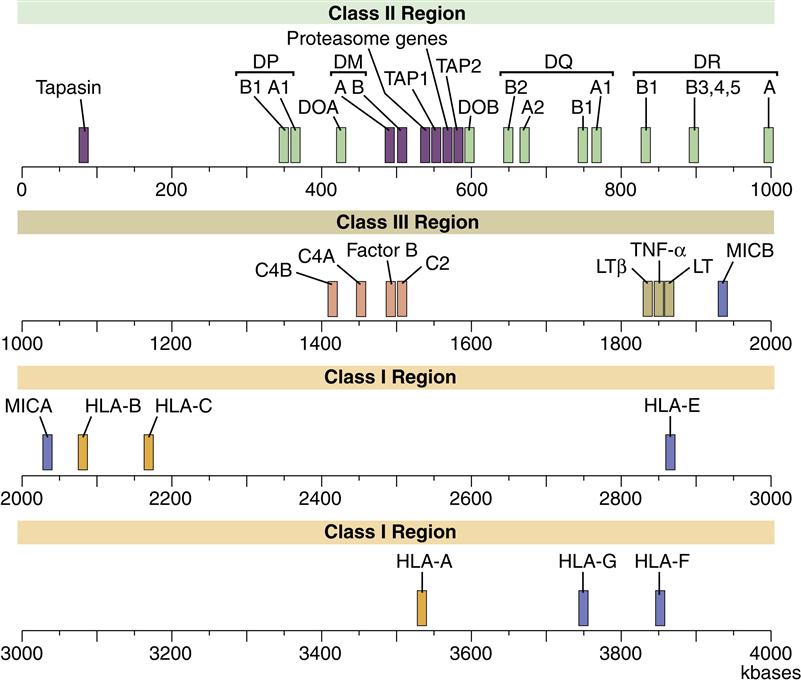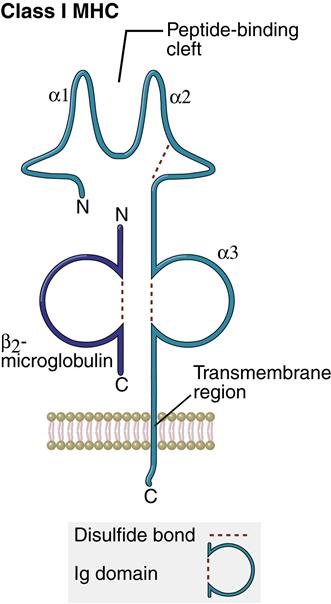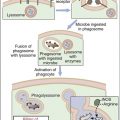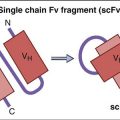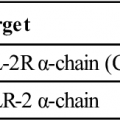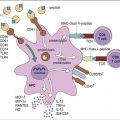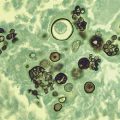Antigen-Presenting Molecules
Learning Objectives
• Explain the functions of HLAs
• Identify the major class I loci
• Identify the major class II loci
• Compare and contrast the structures of class I and II molecules
• Discuss the relationships between class I and class II molecules and CD4 and CD8 cells
• Identify the genes located in HLA class III loci
• Compare and contrast antigens binding to class I and class II molecules
• Understand the value of heterozygosity in species survival
• Explain how recombinant HLA molecules are generated
• Understand the value of allelic polymorphism in species survival
• Define a single nucleotide polymorphism (SNP)
• Restate the structural features of CD1 molecules
• Recognize the biologic function of CD1 molecules
• Define bare lymphocyte syndrome
• Explain the molecular defects associated with bare lymphocyte syndrome
Key Terms
Human leukocyte antigen (HLA) complex
Class I region
Class II region
Class III region
Haplotype
Heterozygosity
Allelic polymorphism
Single nucleotide polymorphism
Introduction
The immune system defends the host against microbial infections and mutant cells. In defense of the host, the immune system must differentiate between foreign proteins and “self-proteins.” Surface display proteins are used as markers of “self.” Early animal skin transplantation studies demonstrated that rejection or acceptance of grafts was dependent on “self” markers mapped to a gene cluster on chromosome 17. This gene cluster was called the major histocompatibility complex (MHC). In humans, the MHC is called the human leukocyte antigen (HLA) complex. The term is derived from the use of white blood cell alloantigens in tissue typing of donors and recipients prior to organ transplantation. Although HLAs are important in transfusion reactions, organ transplantation, and autoimmunity, their most important role is antigen presentation to T cells. In this role, HLA molecules control susceptibility or resistance to infection, the generation of autoimmune responses, and antibody-mediated and cell-mediated responses.
The Human Leukocyte Antigen Complex
The HLA complex is a gene cluster containing 128 functional genes and 96 partial genes or gene fragments called pseudogenes. Most gene products are expressed on nucleated cells in the body, but some are secreted proteins that augment an inflammatory response. On the basis of gene product structure and function, the HLA gene complex is subdivided into class I, II, and III regions. The function of pseudogenes is unclear, but evidence suggests that pseudogenes are coding sequences that contribute to the genetic diversity of HLA molecules. A map of the human MHC or HLA complex is shown in Figure 4-1.
Class I Region
The class I region is subdivided into three major loci, termed HLA-A, HLA-B, and HLA-C, and minor loci consisting of HLA-G, HLA-E, HLA-F, HLA-H, and HLA-J and MHC class I chain–related genes (MIC). The major class I loci (A, B, and C) present antigens to CD8 T cells.
Minor loci have various immunologic functions. HLA-E interacts with CD94 and NKG2 receptors on natural killer (NK) cells to augment or inhibit NK cell function. HLA-F has an unknown function. HLA-G presents a broad range of self-polypeptides with similar molecular structure and is found in high concentrations on the surface of extravillous cytotrophoblast and the placenta. The role of HLA-G in pregnancy is unclear, but it may shift immune responses from Th1 to Th2. The functions of HLA-H and J are unclear.
The MIC family represents a nonclassic HLA gene complex. Gene products are expressed as a stress response to virus infection or cellular damage in the intestine and synovia. Their structure resembles a class I molecule, but MIC gene products cannot present antigens. Expression of MIC marks the cell for destruction by CD8 and NK cells.
Structure of Class I Molecules
Class I molecules comprise a single glycosylated α-chain (394 amino acids), which is noncovalently bound to β2-microglobulin (94 amino acids). The class I protein consists of two intracellular and three extracellular domains. The two intracellular domains attach the molecules to the cell membrane and extend into the cytoplasm. The three extracellular domains—designated α1, α2, and α3—are each composed of 90 amino acids. The α1– and α2– domains have unique helical structures that form an antigen-binding cleft used to present antigens to T cells (Figure 4-2).
Peptides are tethered to the ends of the binding groove usually at positions 2 and 9. Thus, the binding cleft accommodates only small peptides containing 8 to 12 amino acids. Flexing of unbound peptides and side chains within the binding cleft creates a three-dimensional epitope structure that is recognized by T cells. The α3-domain stabilizes the interaction between class I molecules and the lymphocyte T cell receptor.
Class II Region
Class II gene products are induced and expressed on monocytes, macrophages, dendritic cells, and B cells. Within the class II region are three loci (DP, DR, and DQ) involved in antigen presentation. Class II molecules present antigens to CD4Th1 and CD4Th2 cells. Other genes in the class II region code for proteins that are important in antigen processing.
Structure of Class II Molecules
The class II region has three major loci (DP, DQ, and DR). Class II molecules consist of heavily glycosylated α- and β-chains. Although both chains have similar structure, the α-chain is larger (30–34 kiloDaltons [kDa]) compared with the β-chain (26–29 kDa). An antigen-binding cleft comprises the α1– and β1-domains (Figure 4-3). The peptide binding to the class II molecule occurs in the middle of the binding cleft at positions 1, 4, 6, and 9. Peptides are bound in a manner analogous to a long pipe being held in a centrally located vise. Peptides are held in place by hydrogen bonding and van der Waals forces. All class II antigens bind at the same anchor positions. However, they are much larger than class I antigens (10–30 amino acids) and protrude from either end of the cleft.
Stay updated, free articles. Join our Telegram channel

Full access? Get Clinical Tree


